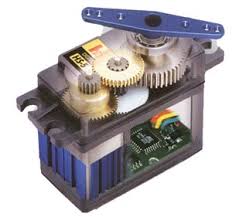 What is Servo Motor ?
What is Servo Motor ?
A Servo Motor is a motor that has an internal gear-based transmission system and electronic control.
Usage of Servo Motors in Robotics Applications
Servo motors are being used in a wide variety of robots, machines, and general robotic applications, including: robotic arms, radio-controlled toy-cars, air-planes and helicopters, industrial machinery and many many more applications. There are many reasons that make servo motors so common – their ease of control, the low energy requirements (efficiency), the high torque, TTL voltage level control, and even the physical properties – servo motors are relatively small sized and have a low weight.Advantages and Disadvantages of Servo Motors
Servo motors are used in many robotics applications, due to many reasons:
- Servo motors usually have a small size
- Servo motors have a large angular force (torque) comparing to their size
- Servo motors operate in a closed loop, and therefore are very accurate
- Servo motors have an internal control circuit
- Servo motors are electrically efficient – they required current is proportional to the weight of the load they carry.
Comparison between Servo motors and Stepper Motors
- The most significant difference between servo motors and stepper motors is the fact servo motors operate in a closed loop while stepper motors operate in an open loop. This means servo motors have an internal feedback – they are able to measure their position, the difference between the actual position and the desired position, and to fix the gap by controlling the motor. Stepper motors, on the other hand have no feedback and thus are more error-prone.
- RC Servo motors are limited to 0-180 degrees of movement and require physical and electrical modification in order to be able to move in 360 degrees. Stepper motors do not have this limit.
- Stepper motors are usually cheaper than servo motors
- Stepper motors lose torque in high rotational speeds, while servo motors do not.
Internal Structure
Working Logarithm
How does a servo motor work?
Servo motor control
Controlling a servo motors is achieved by sending a digital signal to the motor’s control wire. The general idea is sending a square wave signal to the motor, where the wavelength of the wave sets the angle to which the motor will move.
In example, when sending a 1ms pulsed square wave to the motor, it will move to its minimal angle – 0 degrees.
When sending a 1.5ms pulsed square wave to the motor, it will move to its middle angle – 90 degrees.
When sending a 2ms pulsed square wave to the motor, it will move to its ‘largest’ angle – 180 degrees.
When sending a 1.5ms pulsed square wave to the motor, it will move to its middle angle – 90 degrees.
When sending a 2ms pulsed square wave to the motor, it will move to its ‘largest’ angle – 180 degrees.
Schematic diagram:
Servo Wiring
Servo motors have 3 wires:
A brown or black wire, which is negative voltage supply (ground, -)
A red wire which is positive voltage supply (+)
A yellow, orange or white wire that carry the control signal.
In example, in the common HiTec \ Futaba servos:













0 comments:
Post a Comment